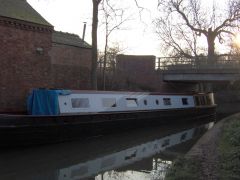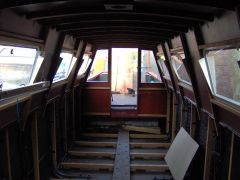-
Posts
227 -
Joined
-
Last visited
Content Type
Profiles
Forums
Events
Gallery
Blogs
Store
Everything posted by grunders
-
I think the OP was asking about securing a centre line to a ring on the bank. Some of the replies give helpful answers about securing the centre rope to the boat in the first place. Also, I agree with Tim about using a bight of rope rather than the end.
-
Thanks for the reply. My initial thoughts on seeing the ropework were (i) it's some sort of clever mechanism to absorb the movement caused by passing boats OR (ii) it's decorative. I'm glad to see that one of my options was correct! On your point about knocking to ask about the knots, I thought that that probably would have been ruder than just taking the photo but, following some of the comments on this thread, I have realised that many people would prefer someone to ask first before taking the photo. Also, if you had been out on deck, I think that I would have enquired but from the original photograph on my computer, I can see that your centre side hatch was padlocked so I think I might have assumed that nobody was aboard.
-
That's rather clever really. The short canals are mostly, if not all, wide so they could use the boat in a breasted up way on them, I suppose. Yes, definitely a good way of doing things if you want a full 57ft of living space but also want to do the Northern canals.
-
Hi, Saw this on youtube. Is it what I think it is: a tug and butty configuration? If it's something else, it certainly looks odd. If it is the tug/butty thing, it's the first one I've seen.
-
Don't mind you asking at all. It's 'Beatty', built in 1937 by Yarwoods of Northwich (AMModels site has some more information on her). There are a few pics in the gallery. In the mud hopper picture, she's got a wooden cabin but we have had a lot of work done recently (in fact it's still happening) and we now have a new wooden bottom and steel cabin. Gallery Link
-
Another mud hopper thing Edited to add: the other end Edited again to say: I have been told by my Dad that this is not, in fact, a 'mud hopper thing' (a term which I was using in a generic sense to mean anything used by BW to put mud in but I have now learned describes a particular type of thing to put mud in - specifically one of the things above with the 'buoyancy tanks') but is, according to him, a BCN Day boat of which his knowledge is sadly limited, mine more so. If it's still there in 12 years perhaps I'll look into it as a restoration project - i.e. 'do an Adamant' (without the steam).
-
Looks like it could be very useful. Thanks very much for sharing!
-
I think that the person(s) concerned could take legal action if they wanted even though the site owner may very well have a good defence (in a defamation action, if the facts were true). However, the proceedings would all probably be very costly and it is best avoiding them if at all possible.
-
It sounds like this is the one to go for. I think I really knew this was the way to do it but it's just that when it comes down to it I always feel as though I'm not leaving enough room for the other boat (which is probably a misconception) and end up easing the boat gently over to the right before we meet so that rather than passing diagonally, we pass parallel to the bank though quite close to the centre of the cut. As to slowing down, everyone seems to agree that it depends on the situation but that slowing down is probably always a good thing. Thanks for all the responses.
-
Thanks for the comments. I will slow down in future and how much will depend upon my own judgement of the situation, as has been said, taking into account depth of the canal.
-

Do other folk find the snobbery in canal boating exasperating??
grunders replied to Byeckerslike's topic in General Boating
I came up with approximately the same thing from a quick google search so I am also puzzled as to offensiveness. -
Possibly a 'Boat Handling' topic but anyway... I have a question prompted by the 'how ruuude!!' topic. Would people expect someone to slow down when they pass you when you are going in opposite directions? I am never sure whether to slow down or not. I find that, if you slow down too much, and the other boat doesn't then they 'steal your water' and you end up on the bottom. However, if you don't slow down then I think it is more likely that both boats will end up on the bottom. So, what do people think, when should you slow down to pass and when is there no need to? Also, with moving over when passing, I generally try to stick close to the middle but will move over 4 feet or so. Most of the time, the other boat moves quite a way over but sometimes you do meet people who do the same thing (i.e. move over slightly) and you pass quite close together. Of course, relating that back to the question, if you slowed down to pass and moved a long way over, I guess you are less likely to hit the other boat than if you stay near the middle and choose to slow down (as you then get pulled towards the other boat, I think). On the other hand, you are probably more likely to hit the bottom especially if the other boat hasn't slowed down. Basically, I just can't decide the best way to pass another moving boat and would appreciate advice.
-
Personally, I like the shape of the barge style narrowboats if done well so that it is nice and 'curvy'. This is mainly because they remind me of proper widebeam barges. If you can't afford a barge, I would think that the barge style narrowboat is a sort of compromise and can certainly look almost as good whilst providing the added advantage of being able to cruise narrow canals. As has been implied in other posts, the one thing that may be seen as a disadvantage or restriction is having to take the wheelhouse down (probably manually) at low bridges etc. However, there are now many 'traditional style' (using that term loosely) narrowboats with those cover things for the steerer who I imagine have the same sort of problems with air draught. In conclusion, they look good, have some advantages and a minor disadvantage which may not be applicable in some comparisons. If you want the little bit more extra space afforded by the design, I say, 'go for it.'
-

Moorings Tendering breaches Sex Discrimination Act
grunders replied to psi's topic in General Boating
Surely the real discrimination happens at the employment stage. If the figures are to be believed, I suppose they show that a woman is likely to be discriminated against by an employer and be paid 29% less than her male conuterpart. The tendering process isn't discriminatory as everyone uses the same system - women and men. Although this may discriminate against women in fact, this is justified as it is not the intention of BW to discriminate and allocating resources by price is a recognised method of ensuring the most efficient allocation of resources in a market economy. -
I reckon it is perfectly safe to sit on the counter if you are below the tiller arm e.g. sitting on a small stool or nothing at all. That way, you can't be swept into the cut even by vigorous steering. I don't recommend steering from that position though as it can be difficult to see where you are going. On a more general note, when steering, I am virtually always in the hatch as that is where the controls are located. If someone needs to get into the boatman's cabin and I anticipate that they will need to come back up again within a short period then, for that period, I will steer standing to the side of the tiller. I have also tried steering whilst standing on the tipcats but this an be difficult as you don't have very much leverage. I guess it is also dangerous as you are unable to reach the throttle controls etc. Crossing from one side of the boat to the other, I generally go under the tiller but sometimes go over the roof and I sometimes go behind the tiller. When not steering, I will often be found standing on the gunnel near the stern (on the opposite side to the cans as they don't leave much room for fingers to grip the handrail). Otherwise I may sit on the roof with feet dangling over the side. P.S. With regard to tiller length, it doesn't matter if the tiller arm is long enough that it will extend beyond the profile of the boat just so long as you remember to remove the tiller as you enter a lock or if you are in restricted space.
-
Keith and Jo Lodge own Hadar. They have a blog at http://narrowboathadar.blogspot.com/
-

River Nene, Middle Levels, the Great Ouse and Cam
grunders replied to Chevetter's topic in General Boating
Parts of the TNC on tour trip reports for the Fens may interest you, here. They are trip reports so do not generally give advice to other boaters but I think they are useful for getting a feel of an area. They are a good general read at any rate. Other than that, I am afraid I can be of no assistance; It has been ages since we were on the the Nene. -
There are some pictures here of the inside of Hadar's boatmans cabin. OK, so it's a new build, but I think it shows what the traditional boatman's cabin should look like.
-
Well, that's interesting. I shall have to keep a look out next time I am there.
-
None, I'm afraid. Should I have been looking out for them?
-
Not what I had imagined but a much more sensible looking craft. Thanks.
-
http://www.goindustry.com/en/saledetails.asp?SaleID=8233 That page says 'Craft to include Piling Boats, Tugs and Whale Suction Boat' I am intrigued to say the least. However, having checked the listings, I can't seem to find it. Anyway, it seems to have done its job - I haven't seen a whale in the cut for years.
-
Agreed, lovely day. Didn't manage to get on a boat but did walk the Nottingham to Beeston cut thingy - fantastic! Not much moving but great to be near the water anyway.



